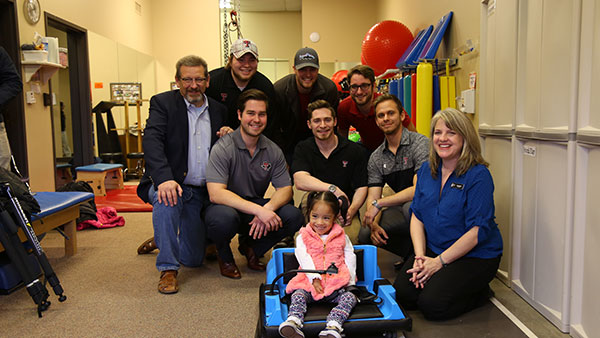The Gift of Mobility
By: Nicole Lundberg
Engineering students design device that offers mobility to disabled toddlers
Most people take depth perception and an awareness of gravity for granted. The parts of the brain responsible for our understanding of these concepts form when we move around spaces independently as toddlers.
Unfortunately, children who have physical disabilities that prevent them from moving independently miss opportunities to develop spatial awareness.
After attending a conference addressing this issue, Pamela Baker, a physical therapist in Lubbock, Texas, reached out to Texas Tech mechanical engineering instructor Jeff Hanson with an idea.
"Pam explained the need for a device that would allow toddlers with physical disabilities to move around independently," Hanson said. "So much development happens in the first two or three years, but everything that exists is too big or too expensive."
Inspired by his conversation with Baker, Hanson tasked a group of students with designing a new technology that would give the gift of mobility to disabled toddlers.
Commissioning a Class

Hanson teaches a portion of a two-semester course that serves as a final graduation requirement for students in the Department of Mechanical Engineering. In the course, students pick from a set of projects he has selected and spend two semesters designing a technology that address a problem, he said.
Sebastian Bahamonde said he and his five teammates were immediately drawn to the project.
"When I picked the project, I only knew we would be helping a child who had mobility issues," he said. "The human aspect of the project really appealed to me. I knew that the technology we created would have a direct impact on a life."
Bahamonde and his classmates worked with Hanson to create a go-cart-like device for a small child. In order to truly offer mobility to disabled toddlers, the design needed to meet certain specifications.
"Safety was our first priority," Hanson said. "The device is as low to the ground as possible, which prevents it from flipping over."
The students also incorporated an emergency stop button and bumpers in case a child collided with a wall or furniture.
Cost and weight also shaped design. Bahamonde said the final device needed to be light enough that a parent could easily move it and significantly less expensive than the wheelchairs already on the market.
Making Design Reality

The students used the university's CB&I Advanced Prototyping and Manufacturing Facility to make their design a reality. Using 3-D printing technologies added to the facility during a recent $1.6 million renovation, they turned their design into a functioning device.
"The students were able to 3-D print the body structure, which gave them freedom to design without the constraints of conventional manufacturing," Hanson said.
The students worked with the Texas Tech Office of Research Commercialization to obtain a provisional patent and hope to commercialize the final product. Because the device is relatively inexpensive and meets specific needs, Hanson said he believes it has potential for commercial success.
"Most motorized wheelchairs cost thousands of dollars," he said. "We manufactured our prototype for $600, and I think it would cost around $300 per device if we mass-produce them. For families who are not wealthy, this makes a big difference."
Legacy
As the students worked late hours in the laboratory bringing their ideas to life, Hanson and Baker connected the students with three-year-old Ava Rosales. Because of physical limitations, Ava had to roll on her stomach to move independently.
Knowing that a little girl was waiting for their device increased the students' desire to complete their project, Bahamonde said. Although Hanson said the team worked all night on multiple occasions, the students became increasingly excited about their work.
"My favorite thing the students said was, 'we aren't doing this for a grade anymore'," Hanson said. "They really wanted to help these kids."
On December 7, 2016, the students gave Ava the gift of mobility in the form of a little blue device that resembles a small go-cart.
For Bahamonde and his teammates who graduated in December 2016, watching Ava explore a room independently in her new cart was a perfect conclusion to their undergraduate education.
"We had an idea that came to life," Bahamonde said. "We graduated, but our project is still alive. Ava will use the device we made at school and at home."
Discoveries
-
Address
Texas Tech University, 2500 Broadway, Box 41075 Lubbock, TX 79409 -
Phone
806.742.3905 -
Email
vpr.communications@ttu.edu
